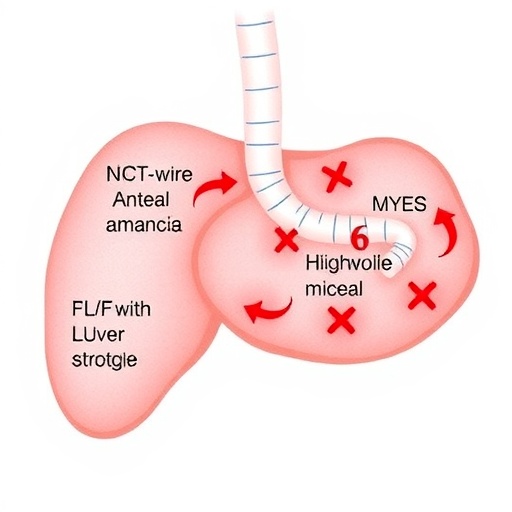
In the evolving landscape of colorectal cancer research, a groundbreaking retrospective cohort study from a high-volume hospital has shed new light on the complex predictors of lymph node metastasis (LNM) in T2 colorectal cancer (CRC). This study, recently published in BMC Cancer, offers profound insights that may revolutionize clinical decisions, potentially sparing a significant subset of patients from unnecessary surgical interventions.
Colorectal cancer remains a formidable adversary in global oncology, ranking as the third most prevalent and the second deadliest malignant tumor affecting the digestive system worldwide. Particularly for T2 stage CRC, the presence or absence of lymph node metastasis plays a pivotal role in treatment planning and prognostication. Historically, the reported incidence of LNM in T2 CRC has oscillated between 18% and 28%, presenting both a challenge and an opportunity for clinicians aiming to balance effective cancer control with patient quality of life.
This extensive study analyzed a substantial cohort of 787 patients diagnosed with T2 CRC, examining a broad spectrum of clinicopathological variables collected preoperatively and postoperatively. By employing robust univariate and multivariate binary logistic regression analyses, the researchers meticulously parsed out factors independently associated with the presence of LNM, quantified through odds ratios (OR) and 95% confidence intervals (CI). Their analytical precision unveils a nuanced profile of risk and protective factors that inform the intricate biology of T2 colorectal tumors.
The incidence of lymph node metastasis identified in this cohort was 23.4%, aligning well with historical data but achieved with a contemporary dataset from a high-volume clinical setting. Within this subset, the majority (78.3%) were classified as N1 stage, indicative of metastasis in 1 to 3 regional lymph nodes, while the remaining 21.7% were N2 stage, reflecting more extensive lymph node involvement. This stratification underscores the heterogeneous nature of nodal metastasis even within the same tumor stage, highlighting the necessity of precision diagnostics.
Among the most striking findings was the identification of poorly differentiated tumors as a significant independent risk factor for LNM. With an OR of 4.405 and a p-value of 0.003, poorly differentiated histology markedly elevates the likelihood of lymphatic spread, corroborating long-held clinical suspicions. Such tumors, characterized by aberrant cellular morphology and aggressive behavior, represent a biological milieu conducive to early metastatic dissemination.
The study further elucidates the critical role of perineural invasion (PNI) and lymphovascular invasion (LVI) as potent predictors of LNM. Perineural invasion, with an OR of 4.789 (p=0.001), and lymphovascular invasion, with an OR of 2.779 (p=0.001), both emerged as formidable indicators that tumor cells have navigated into nerve sheaths and lymphovascular channels, pathways intimately linked with metastatic progression. These pathological features provide tangible evidence of the tumor’s invasive capabilities, extending beyond the primary lesion.
Intriguingly, the analysis also highlighted protective factors against lymph node metastasis. Male sex exhibited a reduced risk, with an OR of 0.652 (p=0.017), suggesting potential underlying sex-based biological or hormonal influences on tumor behavior or host immune response. Additionally, an elevated preoperative platelet-to-lymphocyte ratio (PLR) showed a subtle but statistically significant protective effect (OR=0.996, p=0.048), opening avenues for biomarker-driven risk stratification.
Contrary to prevailing assumptions, tumor size did not demonstrate a statistically significant correlation with lymph node metastasis in this cohort. This finding challenges traditional reliance on tumor dimensionality as a surrogate marker for metastatic potential, signaling a shift toward more sophisticated histopathological and molecular criteria in clinical algorithms.
The implications of these findings are profound. Approximately three-quarters of patients with T2 CRC may be candidates for less aggressive surgical management, reducing the incidence of surgery-related morbidity and preserving postoperative quality of life without compromising oncological safety. The prognostic utility of tumor differentiation, perineural invasion, and lymphovascular invasion equips clinicians with actionable metrics to tailor treatment strategies more precisely.
This landmark study also underscores the importance of comprehensive pathological evaluation in surgical specimens to detect subtle yet critical features predictive of metastasis. It advocates for integrating such pathological parameters into multidisciplinary tumor board discussions, fostering personalized treatment planning that aligns with evolving concepts of precision oncology.
Moreover, the identification of sex and systemic inflammatory markers like PLR as protective factors invites further translational research to unravel underlying mechanisms. The potential interplay of immunological, hormonal, and microenvironmental factors in modulating metastatic risk represents fertile ground for future investigations.
Looking ahead, these insights beckon the development of refined predictive models incorporating clinical, pathological, and biomolecular data to stratify T2 CRC patients with unprecedented accuracy. Such models promise not only to enhance prognostic assessments but also to inform decisions regarding neoadjuvant therapies, surgical extent, and surveillance protocols.
In conclusion, the study offers a compelling narrative that redefines risk assessment in T2 colorectal cancer. By disentangling the intricate web of factors influencing lymph node metastasis, it paves the way for less invasive, more individualized treatment approaches, marking a significant advance in the global fight against colorectal cancer.
Subject of Research: Lymph node metastasis predictors in T2 stage colorectal cancer.
Article Title: Identification of predictors for lymph node metastasis in T2 colorectal cancer: retrospective cohort study from a high-volume hospital.
Article References:
Li, R., Sun, X., Yu, Z. et al. Identification of predictors for lymph node metastasis in T2 colorectal cancer: retrospective cohort study from a high-volume hospital. BMC Cancer 25, 700 (2025). https://doi.org/10.1186/s12885-025-14104-0
Image Credits: Scienmag.com
DOI: https://doi.org/10.1186/s12885-025-14104-0
Tags: BMC Cancer publication on colorectal cancerclinical decision-making in colorectal cancerclinicopathological variables in cancercolorectal cancer research advancementsincidence of lymph node metastasis in CRClymph node metastasis in T2 colorectal cancerpatient quality of life in CRC treatmentpredictors of lymph node spreadprognostic factors for T2 CRCretrospective cohort study on CRCsurgical interventions in colorectal cancerunivariate and multivariate logistic regression in oncology





